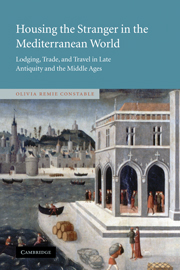 Housing the Stranger in the Mediterranean World
Housing the Stranger in the Mediterranean World Book contents
- Frontmatter
- Contents
- List of illustrations
- List of maps
- Acknowledgments
- Introduction: A culture of travel: words, institutions, and connections
- 1 “Accepting all comers”: a cross-cultural institution in late antiquity
- 2 The transition from Byzantium to the Dār al-Islām
- 3 Commerce, charity, community, and the funduq
- 4 Colonies before colonialism: western Christian trade and the evolution of the fondaco
- 5 Conquest and commercial space: the case of Iberia
- 6 Fondacos in Sicily, south Italy, and the Crusader states
- 7 Changing patterns of Muslim commercial space in the later middle ages
- 8 Christian commerce and the solidification of the fondaco system
- 9 The fondaco in Mediterranean Europe
- Conclusion A changing world: new peoples and institutions in the early modern Mediterranean
- Selected bibliography
- Index
6 - Fondacos in Sicily, south Italy, and the Crusader states
Published online by Cambridge University Press: 27 August 2009
- Frontmatter
- Contents
- List of illustrations
- List of maps
- Acknowledgments
- Introduction: A culture of travel: words, institutions, and connections
- 1 “Accepting all comers”: a cross-cultural institution in late antiquity
- 2 The transition from Byzantium to the Dār al-Islām
- 3 Commerce, charity, community, and the funduq
- 4 Colonies before colonialism: western Christian trade and the evolution of the fondaco
- 5 Conquest and commercial space: the case of Iberia
- 6 Fondacos in Sicily, south Italy, and the Crusader states
- 7 Changing patterns of Muslim commercial space in the later middle ages
- 8 Christian commerce and the solidification of the fondaco system
- 9 The fondaco in Mediterranean Europe
- Conclusion A changing world: new peoples and institutions in the early modern Mediterranean
- Selected bibliography
- Index
Summary
The last chapter examined the consequences of Christian conquest on commercial spaces – specifically funduqs – in the Iberian Peninsula during the period from the eleventh to the thirteenth centuries. But this was not the only region of the Mediterranean world where incoming Christian conquerors encountered and embraced these institutions. In 1080, the Norman leader Robert Guiscard granted a fondaco in Amalfi, with all of its appurtenances, to the monastery of Montecassino. This grant was confirmed by his son, Duke Roger, a decade later, and continued to be cited in papal documents through the next century. Like the contemporary funduq in Valencia, granted to the city's cathedral by Rodrigo Diaz in the 1090s and reconfirmed by his widow Jimena in 1101, this building in Amalfi was evidently a lucrative facility and thus worthy of both donation and repeated notation. In the eastern Mediterranean, Bohemond of Taranto – the crusader son of Robert Guiscard – likewise granted a fondaco to Genoese merchants in Antioch in 1098, shortly after his capture of this city. Possibly this gift reflected the continuation of privileges that Genoese merchants had already enjoyed under Muslim rule (as would later be the case in post-conquest Seville). This Genoese fondaco in Antioch was the first of many similar facilities that would be granted to western merchant communities in crusader cities during the twelfth and thirteenth centuries. The value of these fondacos is demonstrated by their proliferation.
- Type
- Chapter
- Information
- Housing the Stranger in the Mediterranean WorldLodging, Trade, and Travel in Late Antiquity and the Middle Ages, pp. 201 - 233Publisher: Cambridge University PressPrint publication year: 2004


